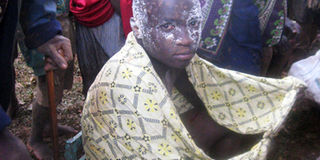Bagisu way of circumcision does not reduce spread of HIV/Aids

In the eastern districts of Sironko, Mbale, Bulambuli, Manafwa and Bududa, when the circumcision season starts, many youths undergone the ritual.
What you need to know:
Two ways of doing the same thing, one claims 5,000 years of history, the other based on research. If medical circumcision can reduce the risk of HIV infection, is it not possible with traditional circumcision?
Mr Pilato Kisangala, 45, a Japadhola, was forcefully circumcised following a Bamasaba cultural fete on June 19 using a crude traditional knife in Mbale.
Kisangala was not alone; a number of other people including Baganda, Iteso, Bagwere, Banyore and Bagisu were also forcefully circumcised by traditional surgeons with an argument that they wanted them to be safe from HIV/Aids.
Although this comes five years after the results from a 2007 research carried out in Rakai, which revealed that male circumcision could reduce HIV infection by up to 60 per cent. But many doctors argue that traditional Bagisu circumcision, which is believed to have started about 5,000 years ago does not reduce the chances of males getting HIV/Aids.
An important landmark
Prof David Serwadda of Makerere University School of Public Health, while presenting a paper, titled Medical Male Circumcision for HIV Prevention, recently at Makerere, said the traditional Bagisu form of circumcision does not give the biological basis on which the research was conducted.
“Although the efficacy of male circumcision in reducing female-to-male sexual transmission of HIV has now been proven after several studies as an important landmark in the history of HIV prevention, the traditional Bagisu male circumcision may not provide the protection because of the way it is done,” said Prof Serwadda. This is slightly over a month from August when the Bagisu in Sironko, Mbale, Bulambuli, Manafwa, and Bududa will launch the 2012 circumcision season.
This will officially kick start the traditional circumcision of boys.
He said while circumcising, the traditional circumcisers destroy the entire inner surface of the foreskin of the penis making it lack keratin, a protein which covers normal skin and protects against the HIV. “Although the medical circumcision protects keratin, the Bagisu traditional circumcision makes the foreskin vulnerable to tears and genital ulcers which provide an entry point for HIV,” added Prof Serwadda and recommended that the Bagisu adopt the medical circumcision for prevention purposes.”
Dr Alex Ario, from the Ministry of Health says, although there is compelling evidence that male circumcision reduces the risk of heterosexually acquired HIV infection in men by approximately 60 per cent.
Three randomised controlled trials showed that male circumcision provided by well-trained health professionals in properly equipped settings is safe. However, people must know that this is only partial cover.
Partial protection
“Male circumcision provides only partial protection, and therefore should be only one element of a comprehensive HIV prevention package which includes: the provision of HIV testing and counselling services, treatment for sexually transmitted infections, the promotion of safer sex practices, the provision of male and female condoms and promotion of their correct and consistent use,” explained Dr Ario.
Although medical experts have condemned the traditional circumcision especially amongst the Bagisu as an easy way of contracting diseases like HIV/Aids and attributed urethra problems amongst boys to it, many traditional circumcisers have not paid heed.
A surgeon at Mbale Regional Hospital, Dr Peter Wakalyembe, says on many occasions the traditional surgeons use one unsterilised knife to circumcise as many candidates. Besides there is no use of gloves and failure to wash hands that put the candidates to risk of not only septic wounds but also transmission of new infections.
“Just last year, we admitted three cases at the hospital due to this traditional circumcision. One of them had his urethra destroyed and he could not urinate so we had to improvise a tube for this,” said Wakalyembe. “There are many of this type who could be ignorantly rotting in the villages.” Mr John Musira, a member of Bagisu Cultural Board, says the Bamasaba would never drop their traditional approach to circumcision but they would retain it and even market it amongst other tribes.
Why change?
“Now when the Ministry of Health realises circumcision is clinically good, why do they want to change the trend of the people who discovered 5,000 years ago that circumcision is a healthy practice?” asks Musira.
He wants the health ministry to get the right values in circumcision in the Kigisu culture and use the local surgeons for circumcising using traditional means.
World Health Organisation and Joint United Nations Programme on HIV/Aids recommend that male circumcision should be considered as an efficacious intervention in countries and regions with heterosexual epidemics, high HIV and low male circumcision prevalence. However, this should be with standard surgical methods for willing adult males.




